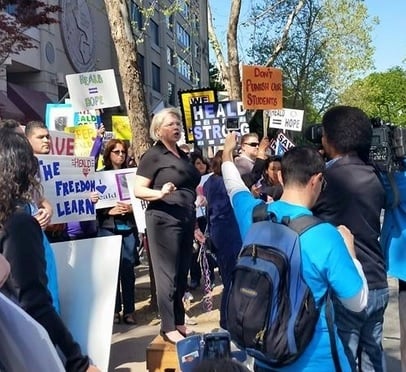You have /5 articles left.
Sign up for a free account or log in.

Heald College President Eeva Deshon at a protest in Sacramento last week
Heald College
The Department of Education will propose next week that borrowers be required to demonstrate their institution intended to mislead them before they can have their loans discharged.
Student advocates say that would effectively mean no borrowers are able to get relief on their student loan debt through a provision of federal statute known as borrower defense to repayment.
Education Secretary Betsy DeVos and the Department of Education are in the midst of an overhaul of borrower-defense regulations through a negotiated rule-making process launched after DeVos blocked a 2016 Obama administration rule from taking effect. Department officials will make the proposal at the second round of meetings between negotiators from a wide range of interest groups.
The proposed language would require that a borrower demonstrate clear and convincing evidence that their college acted with an intent to deceive or misrepresent in claims about job placement rates, licensure passage rates, transferability of credits, enrollment requirements or other facts involving the institution and its graduates. The department proposal would also allow successful claims when a borrower shows their college acted with a “reckless disregard for the truth” or when the borrower has won a judgment against the college in a court or through an arbitrator. The new standards would apply to borrower-defense claims filed on loans issued beginning in July 2019. While the language leaves open other circumstances for a successful claim, most borrowers won’t have the resources, for example, to file a lawsuit against their college, advocates said.
After a surge of borrower-defense claims following the collapse of Corinthian Colleges, the Obama administration crafted a new rule that provided a federal standard for loan relief and clarified how borrowers could pursue their claims. The language being contemplated by the department would maintain a federal standard but make it exceedingly difficult for students to clear that bar.
The proposal won’t be entirely surprising to many who have followed the department's approach to Obama-era regulations. But the requirement is far removed from what was in the 2016 rule and even from what department is currently using to adjudicate existing claims, said Clare McCann, the deputy director of higher education policy at New America and a former department official in the Obama administration.
Jennifer Wang, the Washington office director for the Institute for College Access and Success, said the intent standard would be an unattainable requirement for borrowers to meet.
“It’s going to make getting relief either impossible or very close to impossible for the vast majority of borrowers,” she said.
Negotiators tasked with reaching consensus on a new rule will have the opportunity to weigh in on that language Monday. Colleges themselves, which are among the interest groups represented at negotiations, would likely welcome the tougher standard.
Steve Gunderson, president and CEO of Career Education Colleges and Universities, said in an emailed statement that the Obama administration had crafted the 2016 borrower-defense rule to target the for-profit sector. He said asking for clear and convincing evidence “seems fair.”
“Let’s move away from the department being judge, jury and prosecutor based on minimal evidence of wrongdoing or shutting down a school for the mistakes of a few school staff members,” he said.
When the Obama administration was finalizing its borrower-defense rule in 2016, even college lobby groups outside the for-profit sector argued that borrowers should have to demonstrate intent for a successful claim. They complained that otherwise a mistake by a college employee in a publication or on a website could leave the institution on the hook for the cost of student loan relief. And the National Association of Student Financial Aid Administrators said ahead of the release of a final rule in 2016 that the department should make a distinction between misleading statements and a pattern of fraud or deception.
Mike Goldstein, a lawyer at Cooley LLP who advises colleges on regulatory issues including borrower defense, said via email that the intent standard would be beneficial for institutions and would be reasonable as public policy. Requiring demonstration of intent or reckless disregard for the truth is a common standard of conduct.
But gathering evidence of intent would “likely be nearly impossible for borrowers,” the Obama administration said in comments published along with the final 2016 rule. The department at the time said institutions themselves possessed the best evidence of intent to mislead. And it found that intent on the part of the institution was irrelevant to whether a borrower was harmed.
About 100,000 borrower-defense claims were still pending review by the department at the end of 2017 -- most of them from student borrowers who attended Corinthian institutions. Those claims will be considered under existing standards laid out in 1995 regulations and not under whatever new rule the department eventually produces.
A department spokeswoman, Liz Hill, declined to say how many of those pending claims would clear the proposed intent standard.
“That’s a hypothetical we aren’t going to comment on,” Hill said via email.
In documents provided to rule-making panelists ahead of the first negotiating session in November, the department indicated that it wanted to reconsider the extent to which colleges themselves are liable for findings of fraud or misrepresentation. Issue papers sent to the negotiators ahead of the second session include more detailed proposals of specific regulatory language -- as well as other changes from the 2016 Obama rule.
The 2016 borrower-defense rule had banned mandatory arbitration clauses in college enrollment agreements. The proposed language sent to negotiators would allow those provisions as long as they are disclosed to students. Wang, of TICAS, said that effectively makes it more difficult for student borrowers to take their institutions to court even as the department seeks tougher standards for loan relief through borrower defense.
“They’re going to great lengths to limit relief to students in every possible way,” Wang said.








